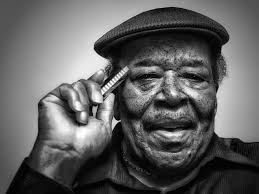James Cotton – A Complete Biography
Introduction
James Henry Cotton (1935–2017) was one of the most electrifying harmonica players in modern blues—an unmistakable live force whose gale-strength tone and showmanship carried Delta and Chicago traditions into rock-era stages worldwide. Apprenticed to Sonny Boy Williamson II, tempered in Muddy Waters’ powerhouse band, and celebrated under his own banner as “Mr. Superharp,” Cotton’s career spanned more than six decades, dozens of albums, and a late-life Grammy.

Childhood
Cotton was born on July 1, 1935, on the Bonnie Blue plantation near Tunica/Clayton, Mississippi, the youngest child of sharecroppers Hattie and Mose Cotton. His mother gave him his first harmonica; as a small boy he mimicked trains and barnyard sounds, a playful start that soon pointed toward a vocation.
By about age nine, Cotton’s uncle introduced him to the star of KFFA’s King Biscuit Time in Helena, Arkansas—Sonny Boy Williamson II (Rice Miller). Williamson took the prodigy under his wing; Cotton lived with him for stretches in Helena and West Memphis, absorbing repertoire, stage craft, and the bluesman’s itinerant life.
Youth
As a teenager in West Memphis, Cotton worked around Williamson’s band and also with Howlin’ Wolf’s circle. He cut his first studio sides in Memphis: backing Wolf (“Saddle My Pony”) and then making solo singles for Sun Records in 1953–54, including the aptly titled “Cotton Crop Blues.” These sessions announced a rough-edged singer/harp man ready for bigger stages.
In 1954–55, Muddy Waters hired Cotton to replace Junior Wells during a Southern tour; Cotton moved to Chicago and would spend roughly twelve years with Muddy’s band, eventually becoming bandleader on the road. He alternated with Little Walter in the studio and, though he wasn’t on every classic single, his stamp is indelible on the band’s live legend—especially the 1960 Newport performance of “Got My Mojo Working,” which helped codify the concert-closing anthem.
Adulthood
Cotton stepped out as a leader in the mid-1960s, appearing on Sam Charters’ Chicago/The Blues/Today! project and forming the James Cotton Blues Band (with players such as Luther Tucker and later Matt “Guitar” Murphy). Through the late ’60s and ’70s he cut a run of high-energy LPs (The James Cotton Blues Band, 100% Cotton, Live & On the Move) and brought harmonica fireworks to rock halls from the Fillmores to festivals, often sharing bills with Janis Joplin, Led Zeppelin, Santana, and the Grateful Dead.
He rejoined Muddy Waters in the Johnny Winter–produced comeback era, playing on the Grammy-winning Hard Again (1977) and subsequent albums, even as he maintained his own touring unit. In the 1980s and ’90s he recorded pivotal releases for Alligator and Verve—High Compression (1984), the Chicago harp summit Harp Attack! (1990), and the acoustic-leaning Deep in the Blues (1996), which earned Cotton a Grammy for Best Traditional Blues Album.
A bout with throat cancer in the mid-1990s limited his singing, but not his firepower on the harp. Cotton kept performing worldwide, mentoring younger players and cutting late-career statements including Giant (2009) and the autobiographical Cotton Mouth Man (2013), a guest-studded celebration of his life in the blues.
Major Compositions (Signature Recordings & Essential Works)
While Cotton was not primarily known as a prolific songwriter, his legacy rests on era-defining recordings and performances that showcased his explosive harmonica style and bandleading:
- “Cotton Crop Blues” (1954, Sun Records): early solo calling card that captured his raw vocal/harp attack.
- With Muddy Waters—“Got My Mojo Working” (live at Newport, 1960): the canonical showstopper that cemented his reputation as Muddy’s onstage spark plug.
- Leader albums: 100% Cotton (1974), High Energy (1975), and the double-LP Live & On the Move (1976), which bottled his whirling-dervish stage act.
- Comeback collaborations: Muddy Waters’ Hard Again (1977) and the summit Harp Attack! (1990, with Junior Wells, Carey Bell, Billy Branch).
- Grammy winner: Deep in the Blues (1996), a rootsy, acoustic-leaning set that proved his artistry transcended sheer volume.
- Late-career portrait: Cotton Mouth Man (2013), with songs co-written by Cotton that narrate his journey and feature guests like Gregg Allman and Keb’ Mo’.
Death
James Cotton died of pneumonia on March 16, 2017, at St. David’s Medical Center in Austin, Texas, at the age of 81. Tributes poured in from across the blues world, hailing both his technical command and the joy he projected from the bandstand.
Conclusion
From a Mississippi plantation to Chicago bandstands to international festivals, James Cotton bridged generations of the blues. He learned at the feet of masters, powered Muddy Waters’ band in its most barnstorming nights, and then turned the harmonica into a rock-era spectacle without losing the idiom’s feeling. Awards and honors—Blues Hall of Fame (2006), a 1996 Grammy, museum recognitions—merely formalize what audiences already knew: Cotton’s harmonica was a force of nature, and his life’s work preserved, modernized, and popularized the blues for millions.

Comments are closed